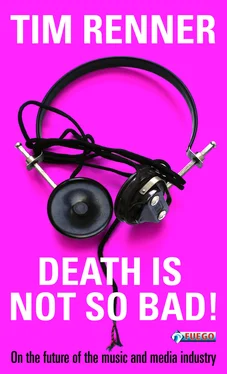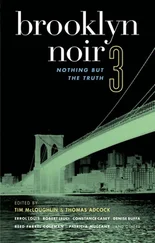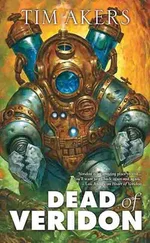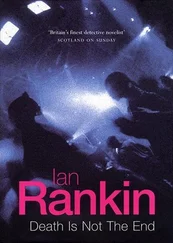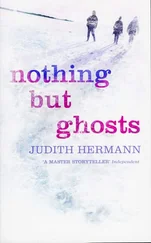Pop = art + capital • mass media. Being a means to an end is a fate with which art has long had to live and which it has repeatedly survived with a deep inner weariness. People have sung, com posed, written and painted for the sake of Christianity, for the glorification of wealthy, powerful patrons and, latterly, after the Industrial Revolution, to accompany the launch of soaps, technical equipment, fried chicken, and much more. Artists, quite justifiably, do not want to be poor. This is a form of romanticism they can do without. It is only required by a public that hopes, voyeur-like, to increase the authenticity of a work by increasing the genuine suffering of the artist. Ideally, this public would prefer to discover and promote artists only after their death. And in this it is strongly supported by the arts and review sections of newspapers, which are frequently suspicious of successful living artists.
Artists do not care about this. What they need is to find any kind of audience, any kind of canvas onto which to project themselves and their art. They express their condition, which they cannot communicate in everyday life, through music, the image, the written word, the performance. They yearn for fame and recognition (all the more, admittedly, the louder their stomachs rumble). Naturally they are prepared to place their craft at the disposal of some other cause as long as it doesn’t go against their artistic principles – not too obviously at any rate.
What fascinates me about pop is that pop culture has the most relaxed relationship with capital. True, the history of art has always been one of financial dependence, but pop doesn’t moan about it. The genius of pop culture lies not in coyly denying money, in trying to make people believe in the ideal of a work of art unsullied by finance, but rather in using it, playing with it, even (from time to time) mocking it. As money has no soul, it doesn’t give a damn. It took me a while to grasp this.
“You fucked up your life, why don’t you smile?” sang Element of Crime, the first band I signed as an employee of the mighty Polydor record company, at Hamburg’s Westwerk concert hall in 1986. I hugged my girlfriend (today the mother of our children) tight, for instead of a smile there were tears on my face. I felt I had been trapped, that I was going to become one of those people who waste their lives working for a corporation with no soul. In my attempt to follow in Bob Woodward’s footsteps, that might perhaps have been the only thing I would have succeeded in exposing. But now that I had urged these nice lads from Berlin Kreuzberg to sign with my company, I had become part of the system. However, the system let itself be used without complaining.
Using the system’s money, we persuaded living legend John Cale, the John Lennon of Velvet Underground, to produce the band. In every other respect the company saved every cent it could. The four members of the band lived together in a room in Swiss Cottage, an area of London as far removed from an Alpine dreamworld as it is possible to get. If you wanted heat, you had to put money into the meter every ten minutes. One thing we had in our favor, though, were pictures by Derek Ridgers, one of the most sought after of all pop photographers, who worked for music paper NME (New Musical Express). Pop needs capital, but even more than that it needs the mass media, which depend in turn on capital investment and operate according to the laws of capitalism. We got the media (the press at least) onto our side for Element of Crime because the names John Cale and Derek Ridgers were redolent of the big, wide world while the record Try To Be Mensch had such a sweet “boys next door” flavor.
For the media the way a pop product is presented is an integral part of that product. The mass media are responsible for conveying a piece of work into the heart of the viewer, reader or listener’s everyday life. Ideally, this happens without warning; it grabs your attention and it moves you – a song heard in a taxi, an article in the newspaper, a picture on TV. It is not unusual for the medium itself to become pop. Pop functions at its best when everyday life is influenced by … the everyday. Pop measures its success by the extent – how deeply and how broadly – to which it achieves this. A decisive factor here is how frequently and how intensely the work reaches the consumer. Pop’s offensive and honest relationship with the mass media and capital also make it incredibly vulnerable – when it results in the responsibility of the artist and of the management structures that surround the artist being overlooked.
At its best, management means moderation; it means applying the brakes in the interests of both sides when content is threatened by capital and/or the medium. Not only does a dearth of content eventually destroy society, it also destroys business. How can consumers be expected to part with their money for something that no longer seems to have any substance? When the only value is the generation of profit, no one should wonder if the charts are reduced to a kind of karaoke bar. Good karaoke singers no doubt make perfectly nice neighbors or work colleagues, but they are not pop stars. Innovation has no place in television talent quests. But a culture that does not renew itself will, at some point, level out.
Pop provides an impressive example of how careers can be ruined when content is lacking over the long term. It is precisely this content that the consumers are searching for in order to be able to define themselves. We are no longer stuck on the fourth level of the famous “hierarchy of needs” pyramid devised more than 60 years ago by behavioral scientist Abraham Maslow. After the need for food, propagation and security comes a need for belonging. In highly developed countries, another need, the need for self-actualization, beckons us one stage higher, to level five.
No longer are we content to be simply a part of the teeming masses; we turn away from the traditional mainstream in an attempt to display originality. In most cases this succeeds only to a certain point. However, it brings about a situation in which it is no longer the “ideal” son-in-law or the dumb blonde sex bomb who make up the new mainstream, but highly individual types who represent the very best within their respective subcultures.
Consumers reveal their putative originality by assembling musical bouquets: Norah Jones, U2, Shania Twain, Eminem and Robbie Williams (naturally). In other words combinations of jazz, alternative rock, country, hip-hop and of course pop – artists from different genres whose styles conflict. Together they form a music collection that would have struck people as schizophrenic a few years ago, as I often discovered. All these performers have a strongly individual profile, are authentic exponents of their respective genres, and stand, each in their own way, for content. They are also, incidentally, the most successful pop artists in the world …
For a long time the music industry ignored the fact that in their thirst for individuality, consumers had actually created a new mainstream. I don’t mean the even-textured sauce that was traditionally considered to be the mainstream. The new mixture consists of the very best in their genres. Instead of building up new icons in these different areas, the music industry responded by creating its own idea of a mainstream: TV talent show acts and instant hits by faceless producers. If the music industry ignores this need for individuality and if, on top of everything else, the next wave of digitalization brings a change of format (such as the change from CD to Internet) that promotes the individuality of the consumer to an extreme degree, this will create a very real problem. One that threatens to suffocate the music industry and which, moreover, is heading inexorably in the direction of movies and television, and possibly other areas too.
Читать дальше
